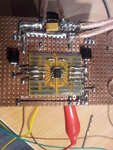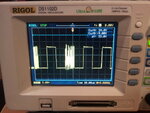gbmhunter
Junior Member level 1
- Joined
- Apr 6, 2011
- Messages
- 16
- Helped
- 1
- Reputation
- 2
- Reaction score
- 1
- Trophy points
- 1,283
- Location
- New Zealand
- Activity points
- 1,419
Hi,
I am currently building a half-bridge motor driver for a 800W DC motor.
I am using the LM5104M half-bridge driver IC to drive the gates of two discrete N-Channel MOSFET's. The driver uses boot-strapping to provide the high-side gate driver.
When testing the circuit, I have noticed problematic oscillations occurring. They get worse as the current increases (e.g. 0.5A to 1A), and get worse as the PWM frequency increases (e.g. 1kHz to 20kHz). Oscillations are seen on the gates of both MOSFETs (especially the high-side gate), and the power rail. The motor makes a scretching sound when this happens and losses quite a bit of power.
I am aware that sharp dV/dt's on the gates can cause oscillations with any parasitic inductance. I am using a prototype circuit and the traces about 40mm long from the driver IC to the gate. I have put two 10ohm gate resistors in place but they did not help. I have a 100nF decoupling cap between power and ground, and a 15uF bulk decoupling cap at the power supply entry point. The bootstrap capacitance is 330nF, and the MOSFET's have a Rds(on) of about 4mOhm.
The pictures below show the half-bridge circuit, and the nasty oscillations on the high-side MOSFET gate.
Any ideas on what could be causing this? Many thanks in advance...
I am currently building a half-bridge motor driver for a 800W DC motor.
I am using the LM5104M half-bridge driver IC to drive the gates of two discrete N-Channel MOSFET's. The driver uses boot-strapping to provide the high-side gate driver.
When testing the circuit, I have noticed problematic oscillations occurring. They get worse as the current increases (e.g. 0.5A to 1A), and get worse as the PWM frequency increases (e.g. 1kHz to 20kHz). Oscillations are seen on the gates of both MOSFETs (especially the high-side gate), and the power rail. The motor makes a scretching sound when this happens and losses quite a bit of power.
I am aware that sharp dV/dt's on the gates can cause oscillations with any parasitic inductance. I am using a prototype circuit and the traces about 40mm long from the driver IC to the gate. I have put two 10ohm gate resistors in place but they did not help. I have a 100nF decoupling cap between power and ground, and a 15uF bulk decoupling cap at the power supply entry point. The bootstrap capacitance is 330nF, and the MOSFET's have a Rds(on) of about 4mOhm.
The pictures below show the half-bridge circuit, and the nasty oscillations on the high-side MOSFET gate.
Any ideas on what could be causing this? Many thanks in advance...


